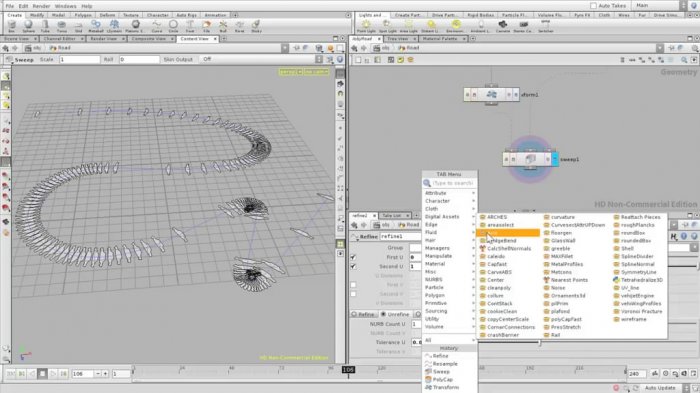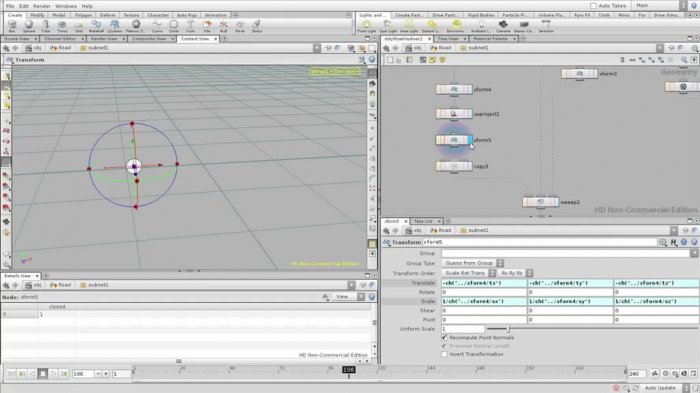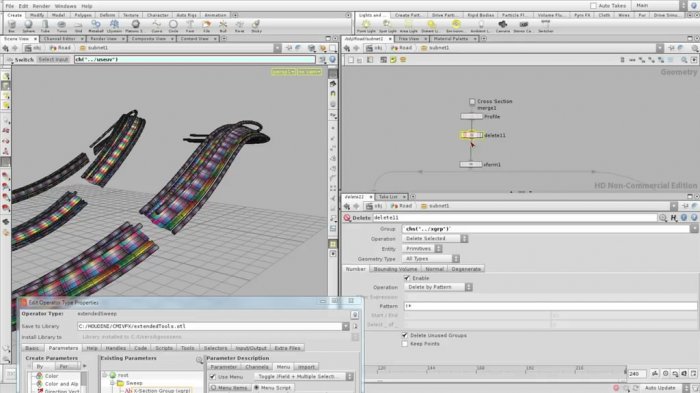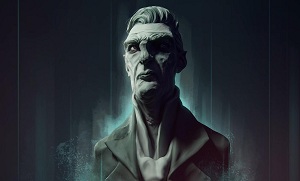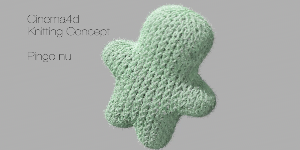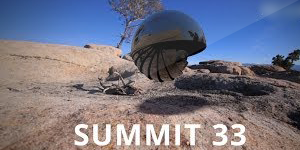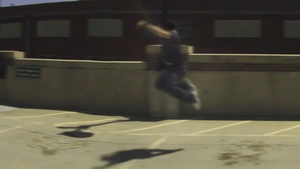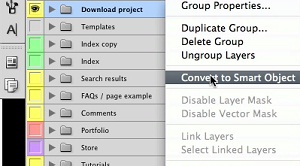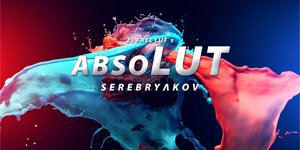Building The Road Shape
Optimized geometry is always very important, we don't want to waist memory and performance on useless geometry compromising the performance of your videogame. We'll show how to optimize the division of the road path shape, fine-tuning it that the most optimal division of the road is being reached without compromising the curvature quality of the road. Only controlling the road-path to create a complete road? You'll learn in detail how to use the sweep-tool to create the road profile along the road path and how to control its heading, pitching and banking.
Creating UV's
A procedural model without UV's looses much of its intended power. Creating proper UV's can be very time consuming are therefore really important to tackle as soon as possible, especially since it will become much harder to create UV's in a procedural way the further you are in the modeling process. You'll learn how to apply UV's in various ways, their implications, how to apply materials onto geometry and even how to use image files directly from internet into Houdini. We'll show the difference between vertex UV's and point UV's and you'll see different solutions to solve unwanted effects such as UV wrapping along the seams.
Preparing The Graph For A Digital Asset
A procedure is almost rendered worthless if it cannot be simplified or collapsed into a single function. Repackaging, recombining your previous effort is the raw power of procedural modeling, allowing you to work at an ever increasing speed with more freedom and flexibility. Here we'll show you how to gradually prepare your graph to become a digital asset by extending its functionality to be able to work with multiple road paths. Using expressions you will learn how to create optimal UV's procedurally independent from the road lengths.
Extending Flexibility
Just like it is really important to get UV's as soon as possible, so is it for groups just as important. Here we'll show how to use a carve tool "in a procedural way of course" to extract the right pieces and give proper names using the group node. You'll learn in detail how to make all UV's working procedurally for multiple profile shapes using expressions and UV transform tools. The capping of the swept road and the UV'ing of those caps is all made procedural in order to make the digital asset more robust.
Creating The Digital Asset
Finally putting everything into a digital asset and with it extending the powerful toolset you have to your disposal. We'll cover in great detail on how to properly create a library of tools, using various input ports of the nodes and making it so that the nodes can determine automatically which functionality to use depending on the number of connected nodes. Now that we have group names in the road profile we show you how to transfer those names using expressions and group nodes to the final geometry.
Creating The Interface
What is a digital asset without an interface? That's right, A Ferrari without a steering wheel! I couldn't have told it better myself. Here we see how we can start creating interfaces in Houdini and connecting its parameters with the functions inside the digital asset. We'll cover in this chapter how to make a dropdown menu that allows creating different segment names by using switch nodes, new expressions and the expressions you have learned in previous parts. Are there too many buttons on the interface that are occasionally useful? You will learn how to make a cleaner interface by graying out elements that depending on the settings.
Making Assets Independent
Sharing the tools you have created amongst your colleagues is one of the noblest acts of charity in life! They will worship you for saving their weekends. Learn how to make your digital assets completely independent by encapsulating all the relevant data. We'll show methods on how to copy whole parts of interfaces and how to bring their functionality to a higher level of control. You will learn how to organize your digital asset in the tab-menu and how to create reference nodes.
Finalizing Assets
The devil always sits in the details, going over all the functionalities added to the digital asset. You'll learn various methods to tackle all these problems. The whole graph inside the digital asset is becoming really big now, learn methods and strategies how to keep an overview so that you are able to handle the most complex graphs. They will also help you colleagues if they need to quickly understand the graphs you are building. We've solved UV seams previously, but solving those for enclosed paths is a whole different ballgame. See how you can solve these problems by thinking out of the box.
- При создании процедурных моделей, мы хотим сохранять простой контроль над параметрами, но с большими возможностями их изменения. В этом курсе показано как создавать простые модели для дороги и как сохранить процедурный контроль над ними. Нам покажут как использовать переменные в сочетании с инструментами трансформации для автоматизации работы.
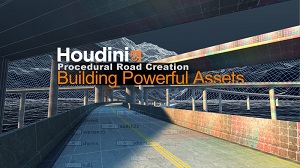 Источник
Источник:
cmiVFXАвтор: Kim Goossens
Качество: хорошее (1024x576)
Язык: Английский
Продолжительность: 4 часа 29 минут
Рабочие файлы: присутствуют
Размер: 445 мб
 Источник: cmiVFX
Источник: cmiVFX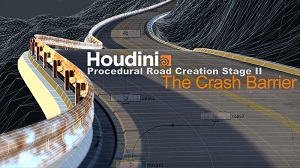 Houdini Procedural Road Creation 2
Houdini Procedural Road Creation 2
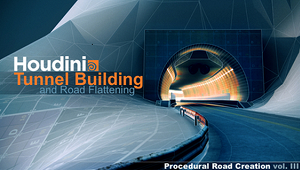 Houdini Procedural Road Creation 3
Houdini Procedural Road Creation 3
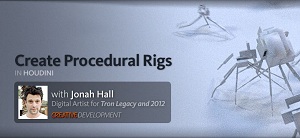 Creative Development: Creating Procedural Rigs and Controlling Motion in Houdini with Jonah Hall
Creative Development: Creating Procedural Rigs and Controlling Motion in Houdini with Jonah Hall
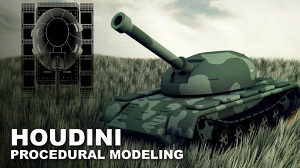 cmiVFX:Houdini Introduction to Procedural Modeling
cmiVFX:Houdini Introduction to Procedural Modeling
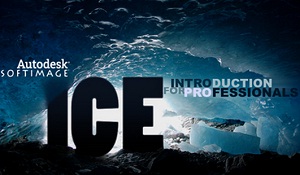 Softimage ICE в процессе разработки компьютерной графики
Softimage ICE в процессе разработки компьютерной графики
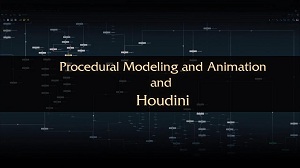 Процедурный моделинг и анимация в Houdini
Процедурный моделинг и анимация в Houdini
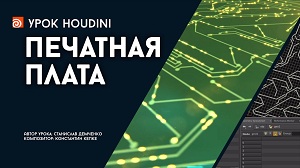 Houdini "Печатная плата"
Houdini "Печатная плата"
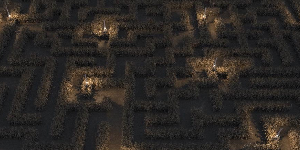 Лабиринт в Houdini
Лабиринт в Houdini
